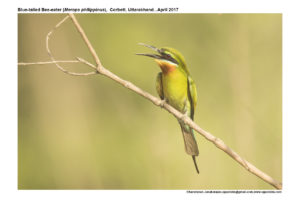
Blue tailed Bee-eater Merops philippinus
Etymology:
- Merops : Greek word for Bee-eater
- Philippinus: From Philippine
Vernacular Names : Hindi: Nildum patringa, Pun: Wadda patranga, Bi: Dorla, Ass: Jeea khatee, Guj: Nilapunch pathrango Ta: Kattalan kuruvi, Panchankam, Te: Komu passiriki, Mal: Velitatha, Kan: Dodda patranga, Sinh: Kurumini kurulla, Natthal kurulla, Ranilla, Ambeya, Nicobar: Shale, Mar: Nilya shepaticha veda raghu
Distribution in India: Summer Visitor in North, East and Central India, Passage Migrant in Central and West India. Winter Visitor in South India
Description: Size of 28–30 cm ; wt. of 29–43 g. It is green above, with blue rump and tail; broad black eyestripe, bordered with narrow blue streak below, usually very thin blue line above. The chin is yellow, throat and cheeks have rufous-tan; underparts are green, undertail-coverts are blue; iris is claret. Both the sexes are alike. The juvenile is duller and bluer, head and body with white feather fringes, chin is yellow-buff, throat is rufous-buff.
Habitat: It is found in mangrove, tidal estuaries, and margins of woodland, forest clearings, lake shores, river valleys, plantations, farmland, paddy fields, and suburban gardens.
Food Habits: It eats honeybees , wasps, hornets and a variety of other hymenopterans, beetles, bugs, flies, moths, butterflies, and numerous dragonflies; small fish. It feeds by making long pursuit-flights from telephone wires, power lines and treetops; makes height with fast, even wing beats, glides, then twists abruptly after its prey; hornets are seized from below, with the bird’s head thrown back and its bill pointing straight up. It returns to perch to beat prey against it and, if a stinger, rubs its tail on the perch to discharge venom. It often forages in continuous flight, usually high over trees.
Breeding Habits: They breed in Feb–Jun North of equator, Feb–May and Sept–Nov near equator. They are colonial breeders, with tens or hundreds of pairs together; sometimes in mixed colonies with Blue-throated Bee-eater or Chestnut-headed Bee-eater . They excavate burrow in dry, sandy or loamy bank of waterway or in flat, grassy ground, roadside cutting, and coastal dune, clay-pan, even in crumbling mud wall of building or in sea cliff. The burrow is 1–2 m long, dug by both sexes. They lay a clutch of 5–7 white eggs.